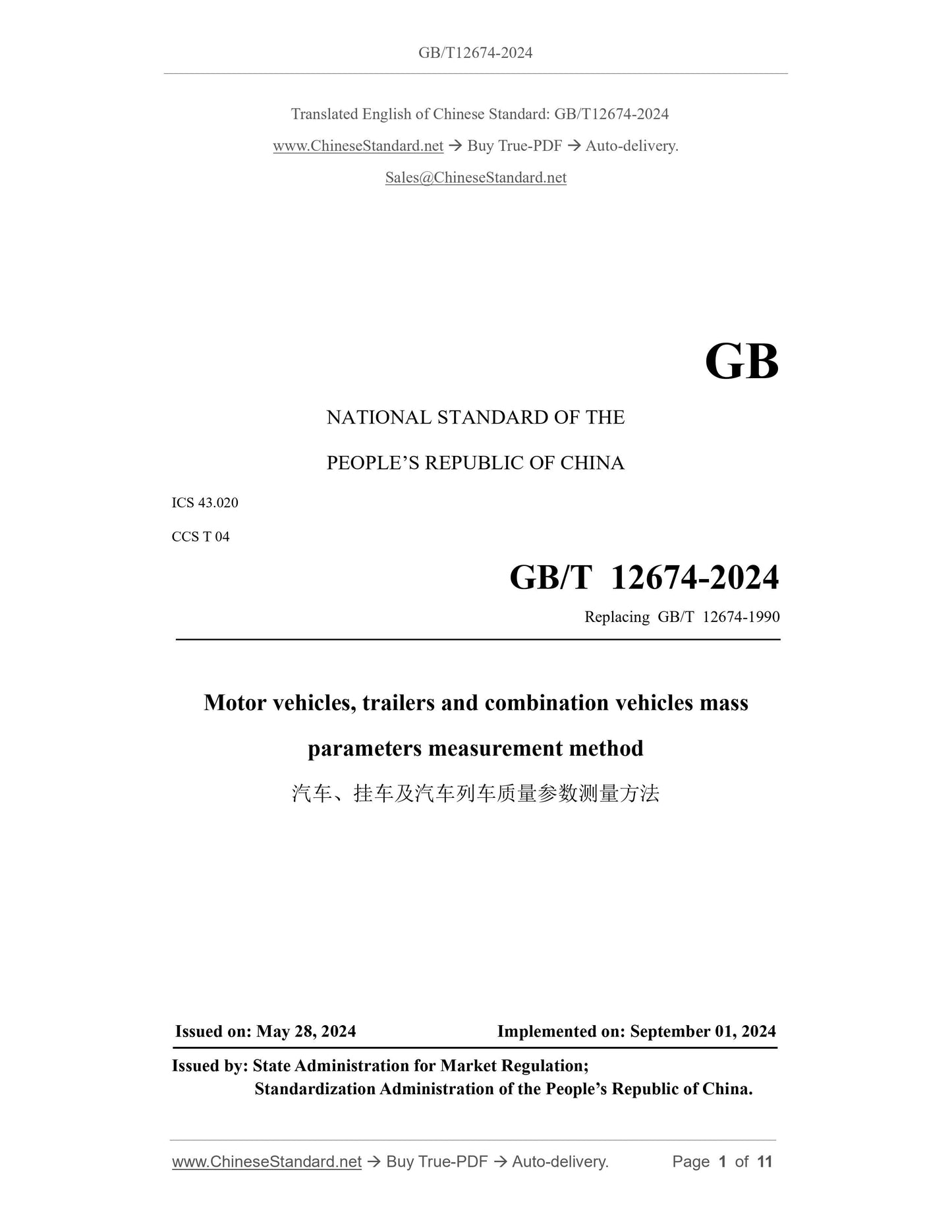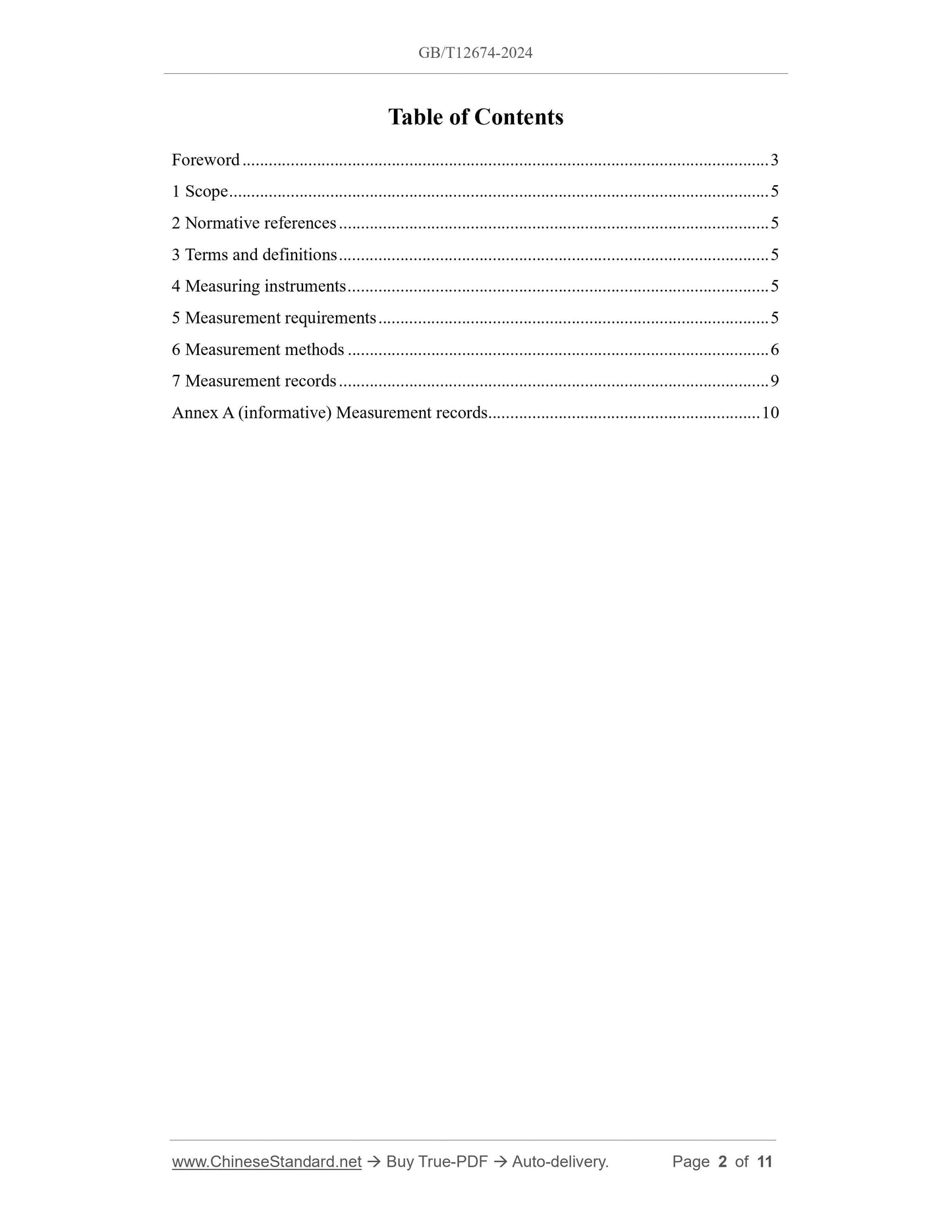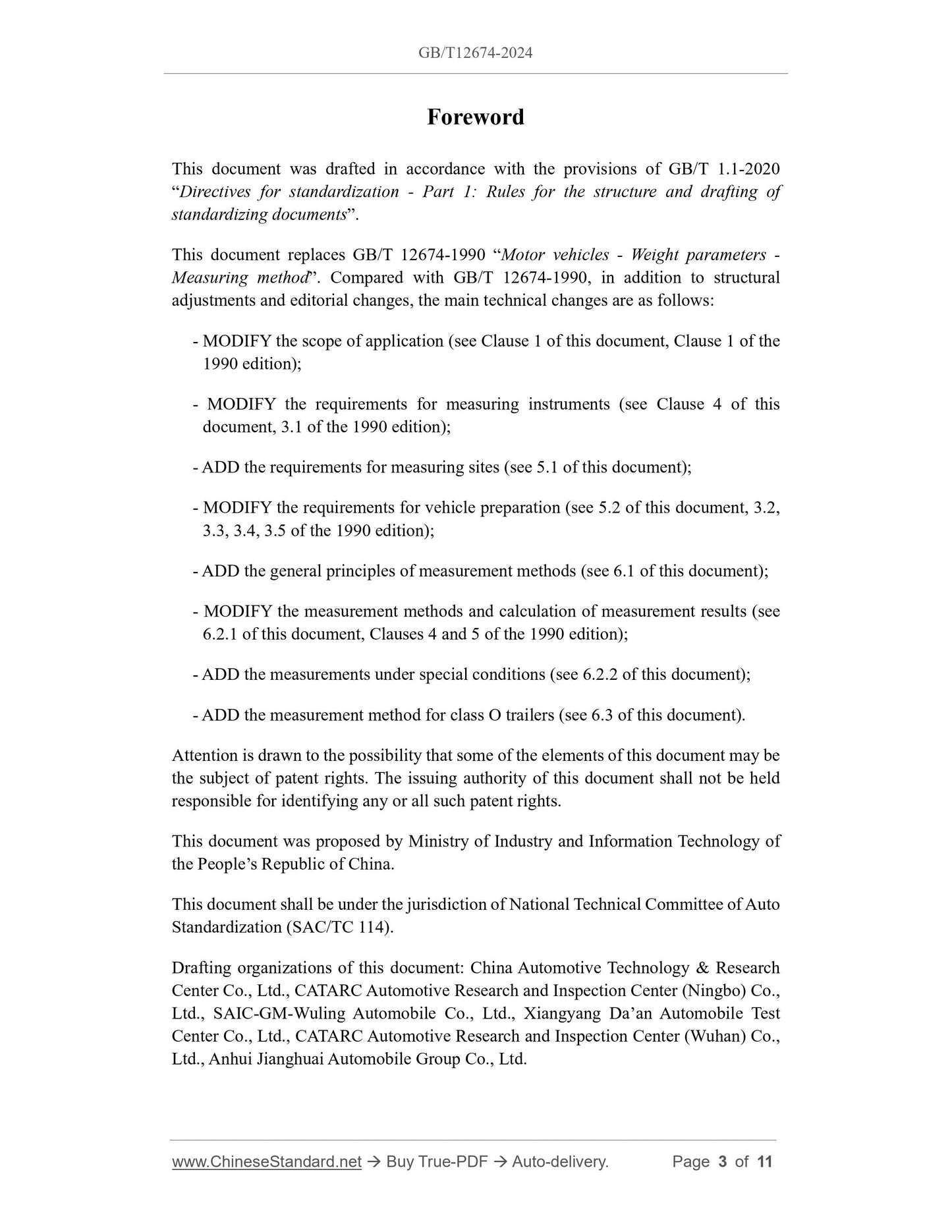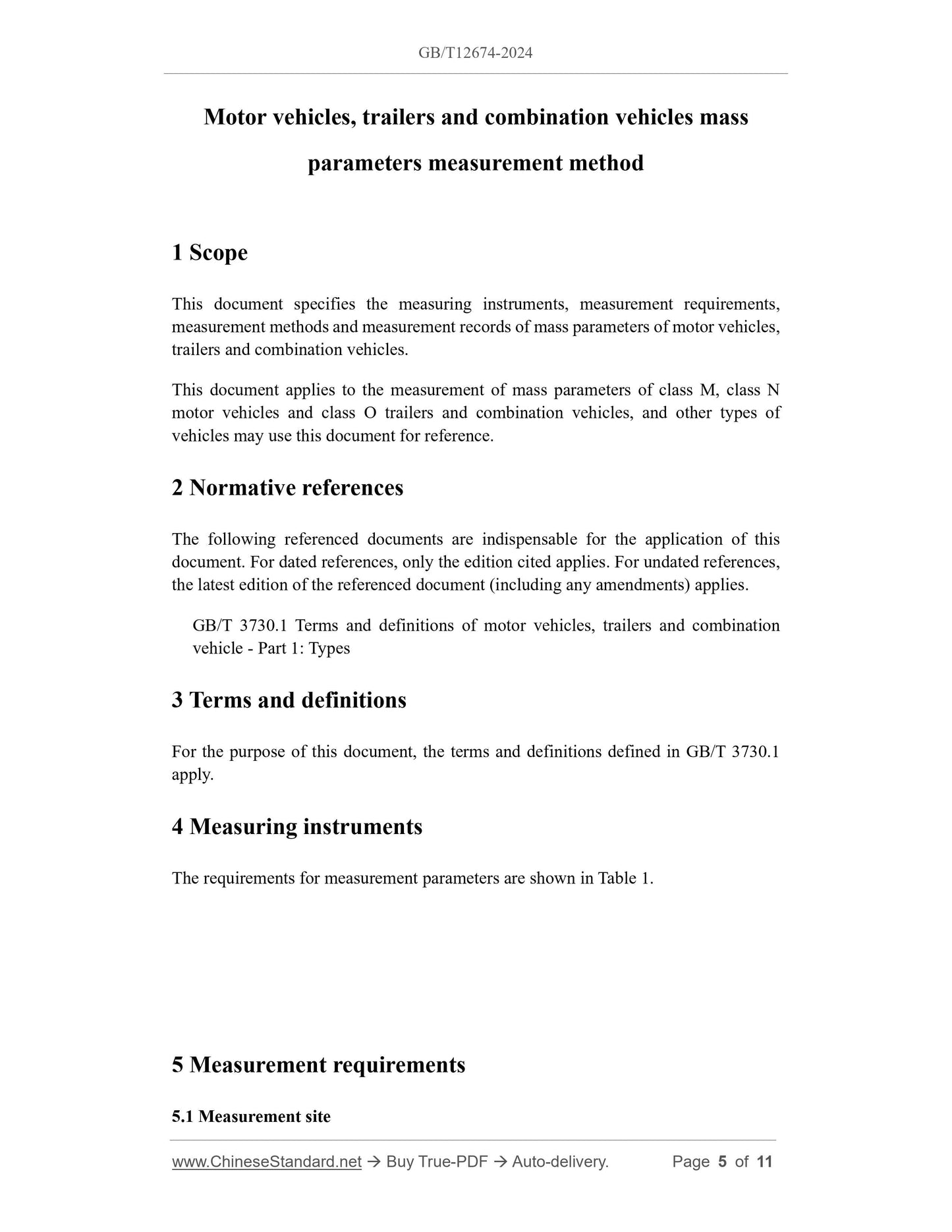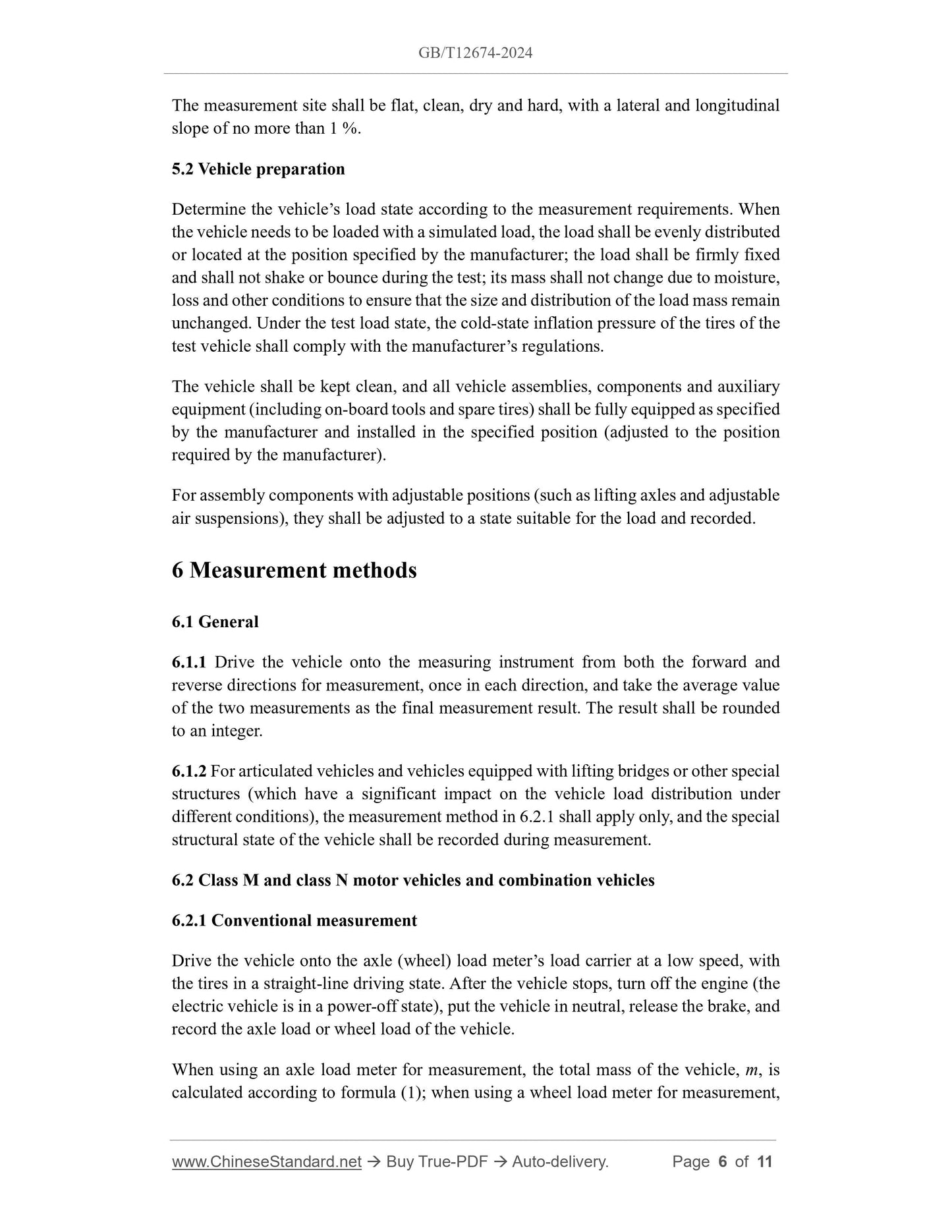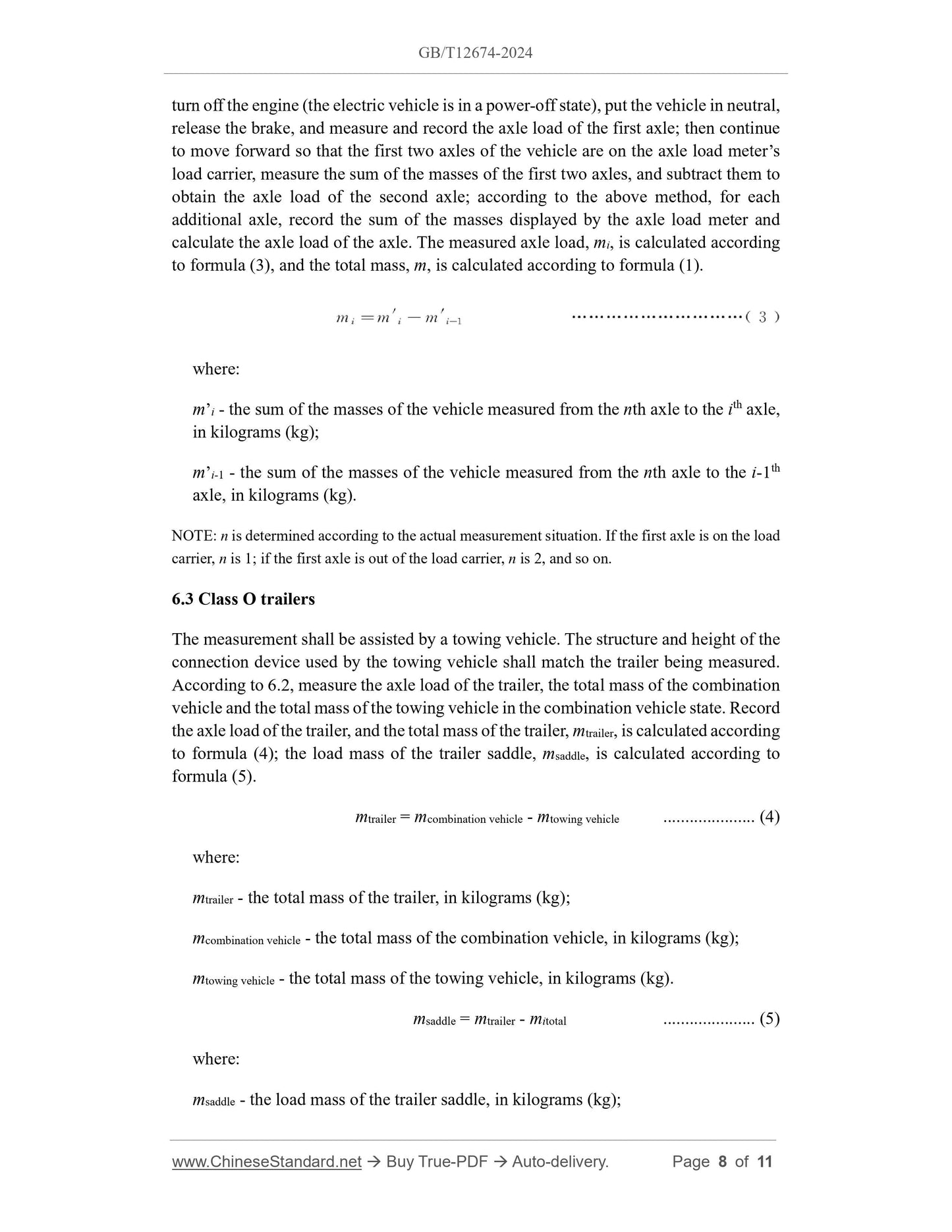1
/
of
6
www.ChineseStandard.us -- Field Test Asia Pte. Ltd.
GB/T 12674-2024 English PDF (GB/T12674-2024)
GB/T 12674-2024 English PDF (GB/T12674-2024)
Regular price
$200.00
Regular price
Sale price
$200.00
Unit price
/
per
Shipping calculated at checkout.
Couldn't load pickup availability
GB/T 12674-2024: Motor vehicles, trailers and combination vehicles mass parameters measurement method
Delivery: 9 seconds. Download (& Email) true-PDF + Invoice.
Get Quotation: Click GB/T 12674-2024 (Self-service in 1-minute)
Historical versions (Master-website): GB/T 12674-2024
Preview True-PDF (Reload/Scroll-down if blank)
GB/T 12674-2024
GB
NATIONAL STANDARD OF THE
PEOPLE’S REPUBLIC OF CHINA
ICS 43.020
CCS T 04
GB/T 12674-2024
Replacing GB/T 12674-1990
Motor vehicles, trailers and combination vehicles mass
parameters measurement method
ISSUED ON: MAY 28, 2024
IMPLEMENTED ON: SEPTEMBER 01, 2024
Issued by: State Administration for Market Regulation;
Standardization Administration of the People’s Republic of China.
Table of Contents
Foreword ... 3
1 Scope ... 5
2 Normative references ... 5
3 Terms and definitions ... 5
4 Measuring instruments ... 5
5 Measurement requirements ... 5
6 Measurement methods ... 6
7 Measurement records ... 9
Annex A (informative) Measurement records ... 10
Foreword
This document was drafted in accordance with the provisions of GB/T 1.1-2020
“Directives for standardization - Part 1: Rules for the structure and drafting of
standardizing documents”.
This document replaces GB/T 12674-1990 “Motor vehicles - Weight parameters -
Measuring method”. Compared with GB/T 12674-1990, in addition to structural
adjustments and editorial changes, the main technical changes are as follows:
- MODIFY the scope of application (see Clause 1 of this document, Clause 1 of the
1990 edition);
- MODIFY the requirements for measuring instruments (see Clause 4 of this
document, 3.1 of the 1990 edition);
- ADD the requirements for measuring sites (see 5.1 of this document);
- MODIFY the requirements for vehicle preparation (see 5.2 of this document, 3.2,
3.3, 3.4, 3.5 of the 1990 edition);
- ADD the general principles of measurement methods (see 6.1 of this document);
- MODIFY the measurement methods and calculation of measurement results (see
6.2.1 of this document, Clauses 4 and 5 of the 1990 edition);
- ADD the measurements under special conditions (see 6.2.2 of this document);
- ADD the measurement method for class O trailers (see 6.3 of this document).
Attention is drawn to the possibility that some of the elements of this document may be
the subject of patent rights. The issuing authority of this document shall not be held
responsible for identifying any or all such patent rights.
This document was proposed by Ministry of Industry and Information Technology of
the People’s Republic of China.
This document shall be under the jurisdiction of National Technical Committee of Auto
Standardization (SAC/TC 114).
Drafting organizations of this document: China Automotive Technology and Research
Center Co., Ltd., CATARC Automotive Research and Inspection Center (Ningbo) Co.,
Ltd., SAIC-GM-Wuling Automobile Co., Ltd., Xiangyang Da’an Automobile Test
Center Co., Ltd., CATARC Automotive Research and Inspection Center (Wuhan) Co.,
Ltd., Anhui Jianghuai Automobile Group Co., Ltd.
Motor vehicles, trailers and combination vehicles mass
parameters measurement method
1 Scope
This document specifies the measuring instruments, measurement requirements,
measurement methods and measurement records of mass parameters of motor vehicles,
trailers and combination vehicles.
This document applies to the measurement of mass parameters of class M, class N
motor vehicles and class O trailers and combination vehicles, and other types of
vehicles may use this document for reference.
2 Normative references
The following referenced documents are indispensable for the application of this
document. For dated references, only the edition cited applies. For undated references,
the latest edition of the referenced document (including any amendments) applies.
GB/T 3730.1 Terms and definitions of motor vehicles, trailers and combination
vehicle - Part 1: Types
3 Terms and definitions
For the purpose of this document, the terms and definitions defined in GB/T 3730.1
apply.
4 Measuring instruments
The requirements for measurement parameters are shown in Table 1.
5 Measurement requirements
5.1 Measurement site
The measurement site shall be flat, clean, dry and hard, with a lateral and longitudinal
slope of no more than 1 %.
5.2 Vehicle preparation
Determine the vehicle’s load state according to the measurement requirements. When
the vehicle needs to be loaded with a simulated load, the load shall be evenly distributed
or located at the position specified by the manufacturer; the load shall be firmly fixed
and shall not shake or bounce during the test; its mass shall not change due to moisture,
loss and other conditions to ensure that the size and distribution of the load mass remain
unchanged. Under the test load state, the cold-state inflation pressure of the tires of the
test vehicle shall comply with the manufacturer’s regulations.
The vehicle shall be kept clean, and all vehicle assemblies, components and auxiliary
equipment (including on-board tools and spare tires) shall be fully equipped as specified
by the manufacturer and installed in the specified position (adjusted to the position
required by the manufacturer).
For assembly components with adjustable positions (such as lifting axles and adjustable
air suspensions), they shall be adjusted to a state suitable for the load and recorded.
6 Measurement methods
6.1 General
6.1.1 Drive the vehicle onto the measuring instrument from both the forward and
reverse directions for measurement, once in each direction, and take the average value
of the two measurements as the final measurement result. The result shall be rounded
to an integer.
6.1.2 For articulated vehicles and vehicles equipped with lifting bridges or other special
structures (which have a significant impact on the vehicle load distribution under
different conditions), the measurement method in 6.2.1 shall apply only, and the special
structural state of the vehicle shall be recorded during measurement.
6.2 Class M and class N motor vehicles and combination vehicles
6.2.1 Conventional measurement
Drive the vehicle onto the axle (wheel) load meter’s load carrier at a low speed, with
the tires in a straight-line driving state. After the vehicle stops, turn off the engine (the
electric vehicle is in a power-off state), put the vehicle in neutral, release the brake, and
record the axle load or wheel load of the vehicle.
When using an axle load meter for measurement, the total mass of the vehicle, m, is
calculated according to formula (1); when using a wheel load meter for measurement,
turn off the engine (the electric vehicle is in a power-off state), put the vehicle in neutral,
release the brake, and measure and record the axle load of the first axle; then continue
to move forward so that the first two axles of the vehicle are on the axle load meter’s
load carrier, measure the sum of the masses of the first two axles, and subtract them to
obtain the axle load of the second axle; according to the above method, for each
additional axle, record the sum of the masses displayed by the axle load meter and
calculate the axle load of the axle. The measured axle load, mi, is calculated according
to formula (3), and the total mass, m, is calculated according to formula (1).
where:
m’i - the sum of the masses of the vehicle measured from the nth axle to the ith axle,
in kilograms (kg);
m’i-1 - the sum of the masses of the vehicle measured from the nth axle to the i-1th
axle, in kilograms (kg).
NOTE: n is determined according to the actual measurement situation. If the first axle is on the load
carrier, n is 1; if the first axle is out of the load carrier, n is 2, and so on.
6.3 Class O trailers
The measurement shall be assisted by a towing vehicle. The structure and height of the
connection device used by the towing vehicle shall match the trailer being measured.
According to 6.2, measure the axle load of the trailer, the total mass of the combination
vehicle and the total mass of the towing vehicle in the combination vehicle state. Record
the axle load of the trailer, and the total mass of the trailer, mtrailer, is calculated according
to formula (4); the load mass of the trailer saddle, msaddle, is calculated according to
formula (5).
mtrailer = mcombination vehicle - mtowing vehicle ... (4)
where:
mtrailer - the total mass of the trailer, in kilograms (kg);
mcombination vehicle - the total mass of the combination vehicle, in kilograms (kg);
mtowing vehicle - the total mass of the towing vehicle, in kilograms (kg).
msaddle = mtrailer - mitotal ... (5)
where:
msaddle - the load mass of the trailer saddle, in kilograms (kg);
GB/T 12674-2024
GB
NATIONAL STANDARD OF THE
PEOPLE’S REPUBLIC OF CHINA
ICS 43.020
CCS T 04
GB/T 12674-2024
Replacing GB/T 12674-1990
Motor vehicles, trailers and combination vehicles mass
parameters measurement method
ISSUED ON: MAY 28, 2024
IMPLEMENTED ON: SEPTEMBER 01, 2024
Issued by: State Administration for Market Regulation;
Standardization Administration of the People’s Republic of China.
Table of Contents
Foreword ... 3
1 Scope ... 5
2 Normative references ... 5
3 Terms and definitions ... 5
4 Measuring instruments ... 5
5 Measurement requirements ... 5
6 Measurement methods ... 6
7 Measurement records ... 9
Annex A (informative) Measurement records ... 10
Foreword
This document was drafted in accordance with the provisions of GB/T 1.1-2020
“Directives for standardization - Part 1: Rules for the structure and drafting of
standardizing documents”.
This document replaces GB/T 12674-1990 “Motor vehicles - Weight parameters -
Measuring method”. Compared with GB/T 12674-1990, in addition to structural
adjustments and editorial changes, the main technical changes are as follows:
- MODIFY the scope of application (see Clause 1 of this document, Clause 1 of the
1990 edition);
- MODIFY the requirements for measuring instruments (see Clause 4 of this
document, 3.1 of the 1990 edition);
- ADD the requirements for measuring sites (see 5.1 of this document);
- MODIFY the requirements for vehicle preparation (see 5.2 of this document, 3.2,
3.3, 3.4, 3.5 of the 1990 edition);
- ADD the general principles of measurement methods (see 6.1 of this document);
- MODIFY the measurement methods and calculation of measurement results (see
6.2.1 of this document, Clauses 4 and 5 of the 1990 edition);
- ADD the measurements under special conditions (see 6.2.2 of this document);
- ADD the measurement method for class O trailers (see 6.3 of this document).
Attention is drawn to the possibility that some of the elements of this document may be
the subject of patent rights. The issuing authority of this document shall not be held
responsible for identifying any or all such patent rights.
This document was proposed by Ministry of Industry and Information Technology of
the People’s Republic of China.
This document shall be under the jurisdiction of National Technical Committee of Auto
Standardization (SAC/TC 114).
Drafting organizations of this document: China Automotive Technology and Research
Center Co., Ltd., CATARC Automotive Research and Inspection Center (Ningbo) Co.,
Ltd., SAIC-GM-Wuling Automobile Co., Ltd., Xiangyang Da’an Automobile Test
Center Co., Ltd., CATARC Automotive Research and Inspection Center (Wuhan) Co.,
Ltd., Anhui Jianghuai Automobile Group Co., Ltd.
Motor vehicles, trailers and combination vehicles mass
parameters measurement method
1 Scope
This document specifies the measuring instruments, measurement requirements,
measurement methods and measurement records of mass parameters of motor vehicles,
trailers and combination vehicles.
This document applies to the measurement of mass parameters of class M, class N
motor vehicles and class O trailers and combination vehicles, and other types of
vehicles may use this document for reference.
2 Normative references
The following referenced documents are indispensable for the application of this
document. For dated references, only the edition cited applies. For undated references,
the latest edition of the referenced document (including any amendments) applies.
GB/T 3730.1 Terms and definitions of motor vehicles, trailers and combination
vehicle - Part 1: Types
3 Terms and definitions
For the purpose of this document, the terms and definitions defined in GB/T 3730.1
apply.
4 Measuring instruments
The requirements for measurement parameters are shown in Table 1.
5 Measurement requirements
5.1 Measurement site
The measurement site shall be flat, clean, dry and hard, with a lateral and longitudinal
slope of no more than 1 %.
5.2 Vehicle preparation
Determine the vehicle’s load state according to the measurement requirements. When
the vehicle needs to be loaded with a simulated load, the load shall be evenly distributed
or located at the position specified by the manufacturer; the load shall be firmly fixed
and shall not shake or bounce during the test; its mass shall not change due to moisture,
loss and other conditions to ensure that the size and distribution of the load mass remain
unchanged. Under the test load state, the cold-state inflation pressure of the tires of the
test vehicle shall comply with the manufacturer’s regulations.
The vehicle shall be kept clean, and all vehicle assemblies, components and auxiliary
equipment (including on-board tools and spare tires) shall be fully equipped as specified
by the manufacturer and installed in the specified position (adjusted to the position
required by the manufacturer).
For assembly components with adjustable positions (such as lifting axles and adjustable
air suspensions), they shall be adjusted to a state suitable for the load and recorded.
6 Measurement methods
6.1 General
6.1.1 Drive the vehicle onto the measuring instrument from both the forward and
reverse directions for measurement, once in each direction, and take the average value
of the two measurements as the final measurement result. The result shall be rounded
to an integer.
6.1.2 For articulated vehicles and vehicles equipped with lifting bridges or other special
structures (which have a significant impact on the v...
Delivery: 9 seconds. Download (& Email) true-PDF + Invoice.
Get Quotation: Click GB/T 12674-2024 (Self-service in 1-minute)
Historical versions (Master-website): GB/T 12674-2024
Preview True-PDF (Reload/Scroll-down if blank)
GB/T 12674-2024
GB
NATIONAL STANDARD OF THE
PEOPLE’S REPUBLIC OF CHINA
ICS 43.020
CCS T 04
GB/T 12674-2024
Replacing GB/T 12674-1990
Motor vehicles, trailers and combination vehicles mass
parameters measurement method
ISSUED ON: MAY 28, 2024
IMPLEMENTED ON: SEPTEMBER 01, 2024
Issued by: State Administration for Market Regulation;
Standardization Administration of the People’s Republic of China.
Table of Contents
Foreword ... 3
1 Scope ... 5
2 Normative references ... 5
3 Terms and definitions ... 5
4 Measuring instruments ... 5
5 Measurement requirements ... 5
6 Measurement methods ... 6
7 Measurement records ... 9
Annex A (informative) Measurement records ... 10
Foreword
This document was drafted in accordance with the provisions of GB/T 1.1-2020
“Directives for standardization - Part 1: Rules for the structure and drafting of
standardizing documents”.
This document replaces GB/T 12674-1990 “Motor vehicles - Weight parameters -
Measuring method”. Compared with GB/T 12674-1990, in addition to structural
adjustments and editorial changes, the main technical changes are as follows:
- MODIFY the scope of application (see Clause 1 of this document, Clause 1 of the
1990 edition);
- MODIFY the requirements for measuring instruments (see Clause 4 of this
document, 3.1 of the 1990 edition);
- ADD the requirements for measuring sites (see 5.1 of this document);
- MODIFY the requirements for vehicle preparation (see 5.2 of this document, 3.2,
3.3, 3.4, 3.5 of the 1990 edition);
- ADD the general principles of measurement methods (see 6.1 of this document);
- MODIFY the measurement methods and calculation of measurement results (see
6.2.1 of this document, Clauses 4 and 5 of the 1990 edition);
- ADD the measurements under special conditions (see 6.2.2 of this document);
- ADD the measurement method for class O trailers (see 6.3 of this document).
Attention is drawn to the possibility that some of the elements of this document may be
the subject of patent rights. The issuing authority of this document shall not be held
responsible for identifying any or all such patent rights.
This document was proposed by Ministry of Industry and Information Technology of
the People’s Republic of China.
This document shall be under the jurisdiction of National Technical Committee of Auto
Standardization (SAC/TC 114).
Drafting organizations of this document: China Automotive Technology and Research
Center Co., Ltd., CATARC Automotive Research and Inspection Center (Ningbo) Co.,
Ltd., SAIC-GM-Wuling Automobile Co., Ltd., Xiangyang Da’an Automobile Test
Center Co., Ltd., CATARC Automotive Research and Inspection Center (Wuhan) Co.,
Ltd., Anhui Jianghuai Automobile Group Co., Ltd.
Motor vehicles, trailers and combination vehicles mass
parameters measurement method
1 Scope
This document specifies the measuring instruments, measurement requirements,
measurement methods and measurement records of mass parameters of motor vehicles,
trailers and combination vehicles.
This document applies to the measurement of mass parameters of class M, class N
motor vehicles and class O trailers and combination vehicles, and other types of
vehicles may use this document for reference.
2 Normative references
The following referenced documents are indispensable for the application of this
document. For dated references, only the edition cited applies. For undated references,
the latest edition of the referenced document (including any amendments) applies.
GB/T 3730.1 Terms and definitions of motor vehicles, trailers and combination
vehicle - Part 1: Types
3 Terms and definitions
For the purpose of this document, the terms and definitions defined in GB/T 3730.1
apply.
4 Measuring instruments
The requirements for measurement parameters are shown in Table 1.
5 Measurement requirements
5.1 Measurement site
The measurement site shall be flat, clean, dry and hard, with a lateral and longitudinal
slope of no more than 1 %.
5.2 Vehicle preparation
Determine the vehicle’s load state according to the measurement requirements. When
the vehicle needs to be loaded with a simulated load, the load shall be evenly distributed
or located at the position specified by the manufacturer; the load shall be firmly fixed
and shall not shake or bounce during the test; its mass shall not change due to moisture,
loss and other conditions to ensure that the size and distribution of the load mass remain
unchanged. Under the test load state, the cold-state inflation pressure of the tires of the
test vehicle shall comply with the manufacturer’s regulations.
The vehicle shall be kept clean, and all vehicle assemblies, components and auxiliary
equipment (including on-board tools and spare tires) shall be fully equipped as specified
by the manufacturer and installed in the specified position (adjusted to the position
required by the manufacturer).
For assembly components with adjustable positions (such as lifting axles and adjustable
air suspensions), they shall be adjusted to a state suitable for the load and recorded.
6 Measurement methods
6.1 General
6.1.1 Drive the vehicle onto the measuring instrument from both the forward and
reverse directions for measurement, once in each direction, and take the average value
of the two measurements as the final measurement result. The result shall be rounded
to an integer.
6.1.2 For articulated vehicles and vehicles equipped with lifting bridges or other special
structures (which have a significant impact on the vehicle load distribution under
different conditions), the measurement method in 6.2.1 shall apply only, and the special
structural state of the vehicle shall be recorded during measurement.
6.2 Class M and class N motor vehicles and combination vehicles
6.2.1 Conventional measurement
Drive the vehicle onto the axle (wheel) load meter’s load carrier at a low speed, with
the tires in a straight-line driving state. After the vehicle stops, turn off the engine (the
electric vehicle is in a power-off state), put the vehicle in neutral, release the brake, and
record the axle load or wheel load of the vehicle.
When using an axle load meter for measurement, the total mass of the vehicle, m, is
calculated according to formula (1); when using a wheel load meter for measurement,
turn off the engine (the electric vehicle is in a power-off state), put the vehicle in neutral,
release the brake, and measure and record the axle load of the first axle; then continue
to move forward so that the first two axles of the vehicle are on the axle load meter’s
load carrier, measure the sum of the masses of the first two axles, and subtract them to
obtain the axle load of the second axle; according to the above method, for each
additional axle, record the sum of the masses displayed by the axle load meter and
calculate the axle load of the axle. The measured axle load, mi, is calculated according
to formula (3), and the total mass, m, is calculated according to formula (1).
where:
m’i - the sum of the masses of the vehicle measured from the nth axle to the ith axle,
in kilograms (kg);
m’i-1 - the sum of the masses of the vehicle measured from the nth axle to the i-1th
axle, in kilograms (kg).
NOTE: n is determined according to the actual measurement situation. If the first axle is on the load
carrier, n is 1; if the first axle is out of the load carrier, n is 2, and so on.
6.3 Class O trailers
The measurement shall be assisted by a towing vehicle. The structure and height of the
connection device used by the towing vehicle shall match the trailer being measured.
According to 6.2, measure the axle load of the trailer, the total mass of the combination
vehicle and the total mass of the towing vehicle in the combination vehicle state. Record
the axle load of the trailer, and the total mass of the trailer, mtrailer, is calculated according
to formula (4); the load mass of the trailer saddle, msaddle, is calculated according to
formula (5).
mtrailer = mcombination vehicle - mtowing vehicle ... (4)
where:
mtrailer - the total mass of the trailer, in kilograms (kg);
mcombination vehicle - the total mass of the combination vehicle, in kilograms (kg);
mtowing vehicle - the total mass of the towing vehicle, in kilograms (kg).
msaddle = mtrailer - mitotal ... (5)
where:
msaddle - the load mass of the trailer saddle, in kilograms (kg);
GB/T 12674-2024
GB
NATIONAL STANDARD OF THE
PEOPLE’S REPUBLIC OF CHINA
ICS 43.020
CCS T 04
GB/T 12674-2024
Replacing GB/T 12674-1990
Motor vehicles, trailers and combination vehicles mass
parameters measurement method
ISSUED ON: MAY 28, 2024
IMPLEMENTED ON: SEPTEMBER 01, 2024
Issued by: State Administration for Market Regulation;
Standardization Administration of the People’s Republic of China.
Table of Contents
Foreword ... 3
1 Scope ... 5
2 Normative references ... 5
3 Terms and definitions ... 5
4 Measuring instruments ... 5
5 Measurement requirements ... 5
6 Measurement methods ... 6
7 Measurement records ... 9
Annex A (informative) Measurement records ... 10
Foreword
This document was drafted in accordance with the provisions of GB/T 1.1-2020
“Directives for standardization - Part 1: Rules for the structure and drafting of
standardizing documents”.
This document replaces GB/T 12674-1990 “Motor vehicles - Weight parameters -
Measuring method”. Compared with GB/T 12674-1990, in addition to structural
adjustments and editorial changes, the main technical changes are as follows:
- MODIFY the scope of application (see Clause 1 of this document, Clause 1 of the
1990 edition);
- MODIFY the requirements for measuring instruments (see Clause 4 of this
document, 3.1 of the 1990 edition);
- ADD the requirements for measuring sites (see 5.1 of this document);
- MODIFY the requirements for vehicle preparation (see 5.2 of this document, 3.2,
3.3, 3.4, 3.5 of the 1990 edition);
- ADD the general principles of measurement methods (see 6.1 of this document);
- MODIFY the measurement methods and calculation of measurement results (see
6.2.1 of this document, Clauses 4 and 5 of the 1990 edition);
- ADD the measurements under special conditions (see 6.2.2 of this document);
- ADD the measurement method for class O trailers (see 6.3 of this document).
Attention is drawn to the possibility that some of the elements of this document may be
the subject of patent rights. The issuing authority of this document shall not be held
responsible for identifying any or all such patent rights.
This document was proposed by Ministry of Industry and Information Technology of
the People’s Republic of China.
This document shall be under the jurisdiction of National Technical Committee of Auto
Standardization (SAC/TC 114).
Drafting organizations of this document: China Automotive Technology and Research
Center Co., Ltd., CATARC Automotive Research and Inspection Center (Ningbo) Co.,
Ltd., SAIC-GM-Wuling Automobile Co., Ltd., Xiangyang Da’an Automobile Test
Center Co., Ltd., CATARC Automotive Research and Inspection Center (Wuhan) Co.,
Ltd., Anhui Jianghuai Automobile Group Co., Ltd.
Motor vehicles, trailers and combination vehicles mass
parameters measurement method
1 Scope
This document specifies the measuring instruments, measurement requirements,
measurement methods and measurement records of mass parameters of motor vehicles,
trailers and combination vehicles.
This document applies to the measurement of mass parameters of class M, class N
motor vehicles and class O trailers and combination vehicles, and other types of
vehicles may use this document for reference.
2 Normative references
The following referenced documents are indispensable for the application of this
document. For dated references, only the edition cited applies. For undated references,
the latest edition of the referenced document (including any amendments) applies.
GB/T 3730.1 Terms and definitions of motor vehicles, trailers and combination
vehicle - Part 1: Types
3 Terms and definitions
For the purpose of this document, the terms and definitions defined in GB/T 3730.1
apply.
4 Measuring instruments
The requirements for measurement parameters are shown in Table 1.
5 Measurement requirements
5.1 Measurement site
The measurement site shall be flat, clean, dry and hard, with a lateral and longitudinal
slope of no more than 1 %.
5.2 Vehicle preparation
Determine the vehicle’s load state according to the measurement requirements. When
the vehicle needs to be loaded with a simulated load, the load shall be evenly distributed
or located at the position specified by the manufacturer; the load shall be firmly fixed
and shall not shake or bounce during the test; its mass shall not change due to moisture,
loss and other conditions to ensure that the size and distribution of the load mass remain
unchanged. Under the test load state, the cold-state inflation pressure of the tires of the
test vehicle shall comply with the manufacturer’s regulations.
The vehicle shall be kept clean, and all vehicle assemblies, components and auxiliary
equipment (including on-board tools and spare tires) shall be fully equipped as specified
by the manufacturer and installed in the specified position (adjusted to the position
required by the manufacturer).
For assembly components with adjustable positions (such as lifting axles and adjustable
air suspensions), they shall be adjusted to a state suitable for the load and recorded.
6 Measurement methods
6.1 General
6.1.1 Drive the vehicle onto the measuring instrument from both the forward and
reverse directions for measurement, once in each direction, and take the average value
of the two measurements as the final measurement result. The result shall be rounded
to an integer.
6.1.2 For articulated vehicles and vehicles equipped with lifting bridges or other special
structures (which have a significant impact on the v...
Share
